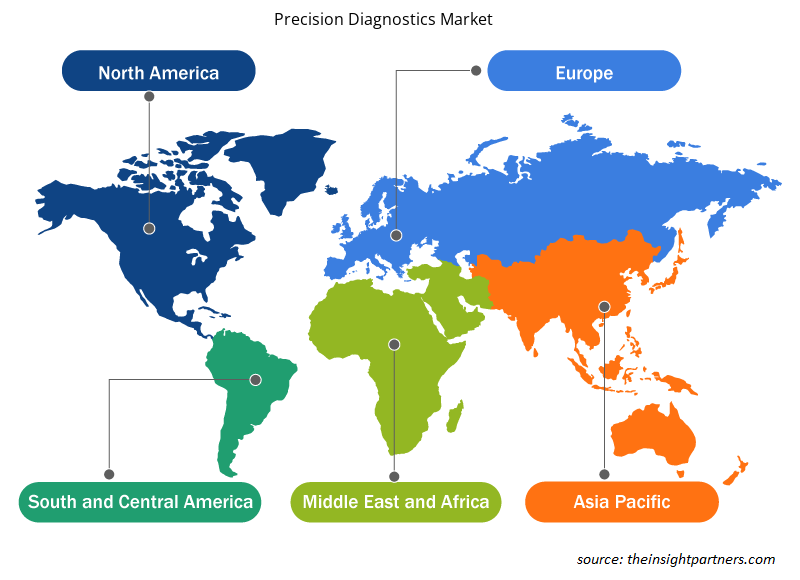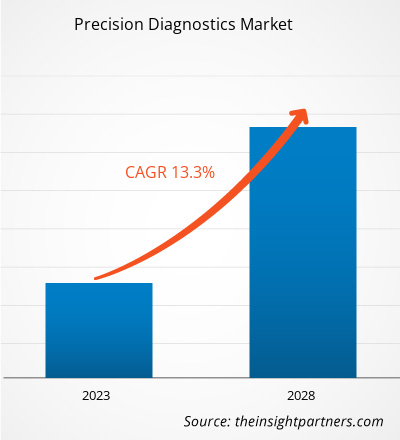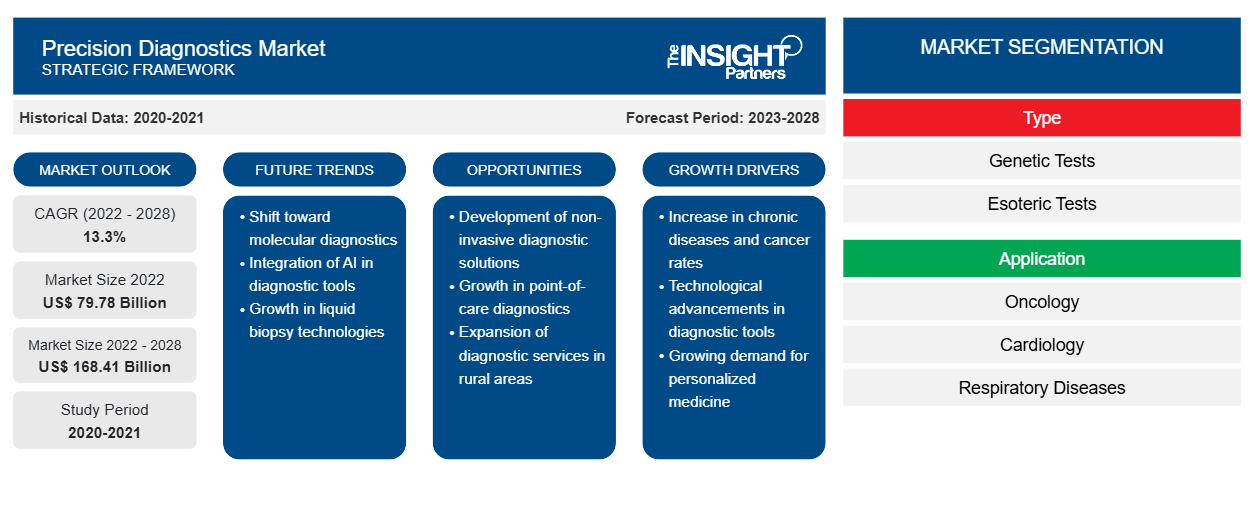[Informe de investigación] Se proyecta que el mercado de diagnóstico de precisión alcance los US$ 168.405,71 millones para 2028 desde los US$ 79.776,88 millones en 2022; se espera que crezca a una CAGR del 13,3% entre 2022 y 2028.
Los diagnósticos de precisión son métodos de diagnóstico de enfermedades que explican el estado del paciente de forma detallada y precisa. Ayudan a los profesionales sanitarios a llevar a cabo los procedimientos de tratamiento de forma eficaz y eficiente. Se utilizan para curar la diabetes, el cáncer y otros trastornos mediante diversas pruebas, incluidas las pruebas esotéricas, las pruebas genéticas y otras.
El mercado de diagnóstico de precisión está segmentado en función del tipo, la aplicación, el usuario final y la geografía. Por geografía, el mercado está segmentado en América del Norte, Europa, Asia Pacífico, Oriente Medio y África, y SAM. El informe de mercado de diagnóstico de precisión ofrece información y un análisis profundo del mercado, haciendo hincapié en parámetros como el tamaño del mercado, las tendencias, los avances tecnológicos y la dinámica del mercado. También proporciona el análisis del panorama competitivo de los principales actores del mercado en todo el mundo. Además, el informe incluye el impacto de la pandemia de COVID-19 en el mercado de diagnóstico de precisión en todas las regiones.
Personalice este informe según sus necesidades
Obtendrá personalización en cualquier informe, sin cargo, incluidas partes de este informe o análisis a nivel de país, paquete de datos de Excel, así como también grandes ofertas y descuentos para empresas emergentes y universidades.
-
Obtenga las principales tendencias clave del mercado de este informe.Esta muestra GRATUITA incluirá análisis de datos, desde tendencias del mercado hasta estimaciones y pronósticos.
El crecimiento del mercado de diagnósticos de precisión se atribuye al creciente número de estudios en desarrollo de nuevos tratamientos contra el cáncer y a las iniciativas gubernamentales para crear conciencia sobre los diagnósticos de precisión entre los trabajadores de la salud de la comunidad. Sin embargo, el alto costo asociado con el diagnóstico y la medicina de precisión restringe el crecimiento del mercado.
Perspectivas de mercado
La creciente aplicación en oncología y otros trastornos impulsa el crecimiento del mercado de diagnósticos de precisión
El concepto de medicina de precisión se está aplicando con fuerza en el tratamiento de enfermedades raras. Aunque es más popular en oncología , se está extendiendo gradualmente a otras especialidades. La creciente prevalencia del cáncer y la creciente incidencia de trastornos neurológicos raros están aumentando la demanda de medicina de precisión, lo que está impulsando el crecimiento del mercado mundial de diagnósticos de precisión. Además, según la Neurological Alliance, en 2019 se registraron alrededor de 14,7 millones de casos neurológicos, y al menos 1 de cada 6 personas padece una o más afecciones neurológicas. Según el Instituto Nacional del Cáncer, se prevé que el número de nuevos casos de cáncer aumente a 29,5 millones para 2040, y las muertes relacionadas con el cáncer aumenten en 16,4 millones. Según la Organización Mundial de la Salud (OMS), la enfermedad de Alzheimer, la forma más común de demencia, contribuye a casi el 60-70% de los casos. Además, a septiembre de 2021, más de 55 millones de personas viven con demencia en todo el mundo, lo que representa casi 10 millones de nuevos casos al año. Además, la creciente demanda de procedimientos de tratamiento en oncología y otros trastornos está impulsando la adopción de procedimientos de tratamiento.
Además, el creciente número de colaboraciones estratégicas entre empresas biofarmacéuticas para desarrollar medicamentos destinados a tratar a un grupo específico de pacientes en función de sus necesidades específicas y proporcionar procedimientos y servicios de tratamiento eficaces está aumentando el número de ensayos clínicos. Por ejemplo, Personal Genome Diagnostics Inc. y el Hospital General de Massachusetts colaboraron para avanzar en el desarrollo de servicios de tratamiento eficaces en 2021. En abril de 2022, se forma el Precision Cancer Consortium (PCC) como una nueva colaboración de empresas farmacéuticas con una visión compartida de proporcionar pruebas integrales a todos los pacientes con cáncer en todo el mundo. Por lo tanto, la creciente aplicación en oncología y otros trastornos impulsa el crecimiento del mercado de diagnósticos de precisión.
Perspectivas basadas en tipos
Según el tipo, el mercado de diagnóstico de precisión se segmenta en pruebas genéticas, pruebas esotéricas y otras. En 2022, el segmento de pruebas genéticas tiene la mayor participación del mercado. Además, se espera que el mismo segmento registre la CAGR más alta del 13,8 % durante el período de pronóstico.
Perspectivas basadas en aplicaciones
Según la aplicación, el mercado de diagnóstico de precisión se segmenta en oncología, cardiología, enfermedades respiratorias, inmunología y otros. El segmento de oncología tiene la mayor participación de mercado en 2022. Además, se prevé que el mismo segmento registre la CAGR más alta del 13,8 % durante el período de pronóstico.
Información basada en el usuario final
Según el usuario final, el mercado de diagnóstico de precisión se segmenta en laboratorios clínicos, hospitales, atención domiciliaria y otros. El segmento de laboratorios clínicos tiene la mayor participación de mercado en 2022. Además, se prevé que el mismo segmento registre la CAGR más alta del 13,8 % durante el período de pronóstico.
Los actores del mercado de diagnóstico de precisión se centran en adoptar estrategias orgánicas, incluido el lanzamiento y la expansión de productos, para expandir su presencia y cartera de productos en todo el mundo y satisfacer las crecientes demandas.
Plataforma de gestión de eventos
Perspectivas regionales del mercado de diagnóstico de precisión
Los analistas de Insight Partners explicaron en detalle las tendencias y los factores regionales que influyen en el mercado de diagnóstico de precisión durante el período de pronóstico. Esta sección también analiza los segmentos y la geografía del mercado de diagnóstico de precisión en América del Norte, Europa, Asia Pacífico, Oriente Medio y África, y América del Sur y Central.

- Obtenga datos regionales específicos para el mercado de diagnóstico de precisión
Alcance del informe de mercado de diagnóstico de precisión
| Atributo del informe | Detalles |
|---|---|
| Tamaño del mercado en 2022 | US$ 79,78 mil millones |
| Tamaño del mercado en 2028 | US$ 168,41 mil millones |
| CAGR global (2022-2028) | 13,3% |
| Datos históricos | 2020-2021 |
| Período de pronóstico | 2023-2028 |
| Segmentos cubiertos |
Por tipo
|
| Regiones y países cubiertos |
América del norte
|
| Líderes del mercado y perfiles de empresas clave |
|
Densidad de actores del mercado de diagnóstico de precisión: comprensión de su impacto en la dinámica empresarial
El mercado de diagnóstico de precisión está creciendo rápidamente, impulsado por la creciente demanda de los usuarios finales debido a factores como la evolución de las preferencias de los consumidores, los avances tecnológicos y una mayor conciencia de los beneficios del producto. A medida que aumenta la demanda, las empresas amplían sus ofertas, innovan para satisfacer las necesidades de los consumidores y aprovechan las tendencias emergentes, lo que impulsa aún más el crecimiento del mercado.
La densidad de actores del mercado se refiere a la distribución de las empresas o firmas que operan dentro de un mercado o industria en particular. Indica cuántos competidores (actores del mercado) están presentes en un espacio de mercado determinado en relación con su tamaño o valor total de mercado.
Las principales empresas que operan en el mercado de diagnóstico de precisión son:
- Quest Diagnostics Incorporated
- QIAGEN
- Swiss Precision Diagnostics GmbH
- Philips NV, la línea Koninklijke
- Imágenes médicas Lantheus, Inc.
Descargo de responsabilidad : Las empresas enumeradas anteriormente no están clasificadas en ningún orden particular.

- Obtenga una descripción general de los principales actores clave del mercado de diagnóstico de precisión
Por geografía
Según la geografía, el mercado de diagnóstico de precisión está segmentado en América del Norte (EE. UU., Canadá y México), Europa (Reino Unido, Alemania, Francia, Italia, España y el resto de Europa), Asia Pacífico (China, Japón, India, Australia, Corea del Sur y el resto de Asia Pacífico), Medio Oriente y África (EAU, Arabia Saudita, Sudáfrica y el resto de Medio Oriente y África) y América del Sur y Central (Brasil, Argentina y el resto de América del Sur y Central).
Perfiles de empresas
- Quest Diagnostics Incorporated
- QIAGEN
- Swiss Precision Diagnostics GmbH
- Philips NV, la línea Koninklijke
- Imágenes médicas Lantheus, Inc.
- Siemens Healthineers AG
- Abad
- Novartis AG
- Sanofi
- Bayer AG
- Análisis histórico (2 años), año base, pronóstico (7 años) con CAGR
- Análisis PEST y FODA
- Tamaño del mercado, valor/volumen: global, regional y nacional
- Industria y panorama competitivo
- Conjunto de datos de Excel
Informes recientes
Testimonios
Razón para comprar
- Toma de decisiones informada
- Comprensión de la dinámica del mercado
- Análisis competitivo
- Información sobre clientes
- Pronósticos del mercado
- Mitigación de riesgos
- Planificación estratégica
- Justificación de la inversión
- Identificación de mercados emergentes
- Mejora de las estrategias de marketing
- Impulso de la eficiencia operativa
- Alineación con las tendencias regulatorias























 Obtenga una muestra gratuita para - Mercado de diagnóstico de precisión
Obtenga una muestra gratuita para - Mercado de diagnóstico de precisión